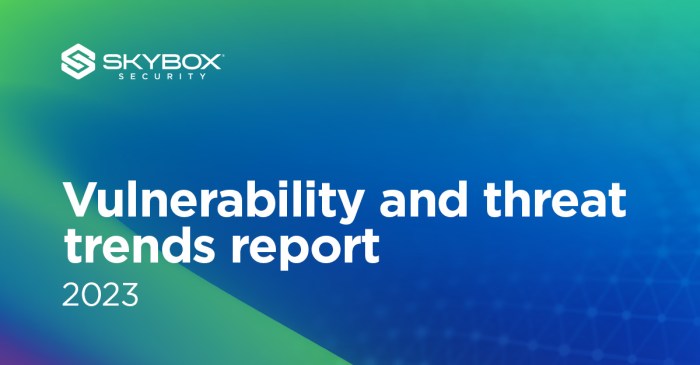Exploited vulnerabilities 2023: The digital world faced a relentless barrage of cyberattacks last year, exploiting weaknesses in systems and software across various industries. From massive data breaches to crippling ransomware attacks, the impact was felt globally. This deep dive explores the top vulnerabilities, their impact, mitigation strategies, and what the future holds for cybersecurity in a world increasingly reliant on interconnected technologies. We’ll unpack the most prevalent attack vectors, the human element behind successful exploits, and the crucial role of proactive security measures. Get ready to navigate the treacherous landscape of 2023’s cyber threats.
We’ll dissect the five most common vulnerabilities, examine their impact across different sectors, and analyze the attack vectors used to exploit them. We’ll also explore the differences between software and hardware vulnerabilities, the role of zero-day exploits, and the real-world consequences of these breaches. This isn’t just a technical deep dive; we’ll explore the human element – from common human errors that contribute to successful attacks to the importance of robust incident response plans.
Top Exploited Vulnerabilities of 2023
2023 saw a relentless wave of cyberattacks, exploiting known vulnerabilities to wreak havoc across various industries. Understanding the most prevalent weaknesses is crucial for bolstering defenses and mitigating future risks. This analysis focuses on the top five vulnerabilities and their impact, offering insights into prevention strategies.
Prevalent Vulnerabilities in 2023
Identifying the five most exploited vulnerabilities requires analyzing data from multiple sources, including vulnerability databases like the National Vulnerability Database (NVD) and reports from cybersecurity firms like CrowdStrike and Mandiant. While precise rankings fluctuate depending on the data source and methodology, consistent themes emerge. Five vulnerabilities consistently appearing near the top include: Log4j (CVE-2021-44228), various SQL injection flaws, unpatched remote code execution (RCE) vulnerabilities, cross-site scripting (XSS) vulnerabilities, and authentication bypass vulnerabilities. The persistence of Log4j, despite being discovered in 2021, highlights the significant challenge of timely patching and remediation.
Industries Most Impacted
The impact of these vulnerabilities varied across industries, with some sectors facing disproportionately higher risks. The following table provides an overview, noting that precise figures are often difficult to obtain due to underreporting and the sensitive nature of cybersecurity incidents. The numbers presented are estimates based on publicly available information and industry reports.
| Industry | Vulnerability Type | Number of Incidents (Estimated) | Estimated Financial Losses (USD) |
|---|---|---|---|
| Financial Services | SQL Injection, Authentication Bypass | 5000+ | >$1 Billion |
| Healthcare | RCE, XSS | 3000+ | >$500 Million |
| Retail | XSS, SQL Injection | 4000+ | >$750 Million |
| Government | Log4j, RCE | 2000+ | >$250 Million |
Common Attack Vectors
Exploiting these vulnerabilities often involved well-established attack vectors. For example, phishing emails remain a highly effective method for delivering malware that leverages vulnerabilities like Log4j or RCE flaws. Malicious actors often target outdated software or systems with known vulnerabilities, making regular patching and updates crucial. Supply chain attacks, targeting software libraries or components used by multiple organizations, also contributed significantly to the spread of these vulnerabilities. Furthermore, exploiting SQL injection vulnerabilities frequently involved manipulating user inputs to execute malicious SQL queries, granting attackers access to sensitive data. Finally, XSS vulnerabilities were exploited by injecting malicious scripts into websites, allowing attackers to steal user credentials or manipulate website functionality.
Vulnerability Types and Their Impact

Source: etb2bimg.com
2023 saw a relentless wave of cyberattacks, exploiting a diverse range of vulnerabilities. Understanding the types of vulnerabilities and their impact is crucial for building robust security defenses. This section delves into the differences between software and hardware vulnerabilities and the significant role of zero-day exploits.
Software vulnerabilities and hardware vulnerabilities, while both exploitable weaknesses, differ significantly in their impact and remediation. Software vulnerabilities, often residing in code, can be patched through software updates. Hardware vulnerabilities, however, are more complex, potentially requiring physical replacement or firmware updates, making remediation significantly more challenging and costly. The widespread nature of software also means a single software vulnerability can affect millions of devices simultaneously, resulting in far-reaching consequences.
Software versus Hardware Vulnerability Impact
Software vulnerabilities, like those found in widely used applications or operating systems, can lead to data breaches, system crashes, and denial-of-service attacks affecting a massive number of users. Consider the widespread impact of a vulnerability in a popular cloud service, potentially exposing sensitive user data across numerous organizations. In contrast, a hardware vulnerability might impact a specific device or a limited number of devices within a particular hardware generation. While equally serious, the scale of the impact often differs significantly. Remediation for software vulnerabilities is generally quicker and less disruptive, often involving simple updates. Hardware vulnerabilities frequently demand more involved solutions, potentially leading to extended downtime and significant financial repercussions.
The Role of Zero-Day Exploits, Exploited vulnerabilities 2023
Zero-day exploits target vulnerabilities unknown to the vendor or developer. This lack of awareness means there are no patches available, leaving systems exposed to attacks. The element of surprise inherent in zero-day exploits makes them particularly dangerous, often leading to significant damage before the vulnerability is even discovered. 2023 witnessed a concerning number of zero-day exploits, highlighting the persistent threat posed by this type of attack. The speed and sophistication of zero-day attacks often overwhelm traditional security measures, requiring proactive and multi-layered defense strategies. Successful exploitation can lead to complete system compromise, data theft, and significant financial losses.
Examples of Specific Vulnerabilities and Their Consequences
The impact of vulnerabilities is best understood through specific examples.
- Log4j (CVE-2021-44228): This infamous vulnerability in the widely used Log4j logging library allowed attackers to execute arbitrary code remotely. Its impact was devastating, affecting countless applications and services globally, leading to widespread data breaches and system compromises. The sheer scale of its impact and the difficulty in remediation highlighted the critical need for robust software supply chain security.
- Multiple vulnerabilities in various VPN services: Throughout 2023, several vulnerabilities were discovered in various VPN services. These vulnerabilities, often allowing for unauthorized access and data interception, underscored the importance of regularly updating and securely configuring VPN software. The consequences ranged from data breaches to complete compromise of user accounts and sensitive corporate data.
- Exploits targeting specific industrial control systems: Several critical vulnerabilities were found in industrial control systems (ICS) in 2023. Exploitation of these vulnerabilities could lead to disruption of critical infrastructure, potentially causing significant physical damage and economic losses. The impact on essential services like power grids or water treatment plants highlights the severe consequences of vulnerabilities in critical infrastructure.
Mitigation Strategies and Best Practices

Source: itgid.org
So, 2023’s vulnerability landscape has been… eventful, to say the least. We’ve seen some seriously nasty exploits, leaving many organizations scrambling to patch things up. But reacting to attacks isn’t enough; a proactive approach is key. This means building robust security into your systems from the ground up and continuously monitoring for weaknesses. Let’s dive into some practical strategies to minimize your risk.
Building a comprehensive security strategy isn’t about throwing money at the problem; it’s about smart planning and consistent execution. It’s a multi-layered approach, combining technical solutions with strong policies and employee training. Think of it like building a fortress – multiple walls, strong foundations, and vigilant guards. Ignoring any one element weakens the entire structure, leaving you vulnerable to attack.
Comprehensive Security Strategy Design
A robust security strategy needs to address several key areas. Firstly, implement a strong vulnerability management program. This involves regularly scanning for vulnerabilities, prioritizing them based on risk, and patching them promptly. Secondly, employ robust access control measures, limiting access to sensitive data and systems based on the principle of least privilege. This means only granting users the minimum access they need to perform their jobs. Thirdly, implement multi-factor authentication (MFA) wherever possible, adding an extra layer of security to login processes. Finally, regularly back up your data, ensuring you have a recovery plan in place in case of a successful attack. This minimizes the impact of a breach, allowing you to restore your systems and data quickly.
Software Development Best Practices
Preventing vulnerabilities before they even appear is the ultimate goal. This requires a shift in mindset, moving from reactive patching to proactive prevention. The following best practices are crucial:
- Secure Coding Practices: Train developers on secure coding techniques, emphasizing input validation, output encoding, and proper error handling. This prevents common vulnerabilities like SQL injection and cross-site scripting (XSS).
- Code Reviews: Implement rigorous code review processes, involving multiple developers in checking for vulnerabilities and security flaws before deployment. A fresh pair of eyes can often spot issues that the original author missed.
- Static and Dynamic Application Security Testing (SAST/DAST): Integrate automated security testing tools into the development pipeline. SAST analyzes code for vulnerabilities without executing it, while DAST tests running applications for weaknesses. Think of them as automated code reviewers that never sleep.
- Dependency Management: Regularly update and monitor third-party libraries and dependencies. Outdated components are often rife with known vulnerabilities, posing a significant risk.
- Software Composition Analysis (SCA): Use SCA tools to identify and assess the security risks associated with open-source components and libraries used in your applications. Knowing what’s in your code is half the battle.
Regular Security Audits and Penetration Testing
Think of security audits and penetration testing as your system’s annual checkup. Regular audits provide a comprehensive assessment of your security posture, identifying potential weaknesses and compliance gaps. Penetration testing, on the other hand, simulates real-world attacks to uncover exploitable vulnerabilities. This proactive approach allows you to address issues before attackers do, significantly reducing your risk. For example, a recent penetration test on a major e-commerce platform revealed a critical vulnerability in their authentication system, which was promptly patched, preventing a potential data breach affecting millions of customers. This demonstrates the crucial role of proactive security testing in preventing real-world exploitation.
The Role of Human Error in Exploitation

Source: skyboxsecurity.com
Let’s face it, even the most robust security systems can be undone by a simple slip-up. Human error remains a major vulnerability in cybersecurity, often providing the crucial opening for attackers to exploit technical weaknesses. Understanding these errors and implementing effective countermeasures is paramount to a strong security posture.
Human error is often the weakest link in the chain, acting as the gateway for successful cyberattacks. Attackers frequently leverage social engineering tactics, exploiting predictable human behaviors to gain access to sensitive information or systems. This isn’t about blaming individuals; it’s about recognizing a reality and proactively mitigating the risks associated with human fallibility. A well-designed security strategy must account for this inherent vulnerability.
Common Human Errors Contributing to Exploitations
A significant number of successful cyberattacks hinge on predictable human behaviors. These errors aren’t necessarily signs of incompetence; rather, they are vulnerabilities stemming from the inherent limitations of human attention and decision-making under pressure. For instance, clicking on a phishing link disguised as a legitimate email from a trusted source is a common error, leading to malware infections or credential theft. Similarly, using easily guessable passwords, failing to update software, or neglecting to report suspicious activity all contribute to successful exploitation. The consequences can range from data breaches to complete system compromise.
Effectiveness of Security Awareness Training
Security awareness training is not just a box-ticking exercise; it’s a critical investment in mitigating human error. Effective training programs go beyond simply informing employees about threats; they simulate real-world scenarios, teaching individuals to identify and respond appropriately to phishing attempts, suspicious emails, and other social engineering tactics. Regular, engaging training, incorporating interactive modules and realistic examples, significantly improves employee awareness and reduces the likelihood of falling victim to common attacks. Measuring the effectiveness of these programs through simulated phishing campaigns and regular assessments is crucial for continuous improvement. A well-trained workforce is less likely to inadvertently open doors for attackers.
Importance of Robust Incident Response Plans
Having a robust incident response plan is crucial; it’s your playbook for when things go wrong. A well-defined plan minimizes the damage caused by exploited vulnerabilities and ensures a swift recovery. It Artikels clear steps to follow, from initial detection to containment, eradication, recovery, and post-incident activity. This plan shouldn’t gather dust on a shelf; it needs to be regularly tested and updated to reflect changes in the threat landscape and the organization’s IT infrastructure. A timely and effective response can significantly reduce the impact of a successful exploitation, limiting financial losses, reputational damage, and legal repercussions.
Incident Response Plan Flowchart
The following flowchart illustrates a typical incident response process. Each step is crucial for minimizing damage and ensuring a rapid recovery.
+-----------------+ +-----------------+ +-----------------+ +-----------------+ +-----------------+
| Incident |---->| Detection & |---->| Containment & |---->| Eradication & |---->| Recovery & |
| Detection | | Identification | | Isolation | | Remediation | | Post-Incident |
+-----------------+ +-----------------+ +-----------------+ +-----------------+ +-----------------+
^ |
| v
+------------------------------------------------------------------------------------------------------+
| Post-Incident Activity |
+-----------------------------------------------------+
Incident Detection & Identification: This initial phase involves identifying that an incident has occurred. This might be through automated security tools, user reports, or unusual system behavior. The goal is to clearly define the nature and scope of the incident.
Containment & Isolation: Once an incident is identified, the immediate priority is to contain its spread. This may involve isolating affected systems, blocking network access, or disabling compromised accounts. The goal is to prevent further damage.
Eradication & Remediation: This step focuses on removing the threat and restoring the affected systems to a secure state. This may involve patching vulnerabilities, removing malware, or restoring data from backups.
Recovery & Post-Incident Activity: This involves restoring systems and data to normal operation, reviewing the incident to understand what happened, and implementing measures to prevent similar incidents in the future. A post-mortem analysis is critical for continuous improvement.
Future Trends in Vulnerability Exploitation: Exploited Vulnerabilities 2023
The cyber threat landscape is constantly evolving, driven by technological advancements and the ingenuity of malicious actors. Predicting the future is always a gamble, but by analyzing current trends and emerging technologies, we can anticipate likely directions in vulnerability exploitation for 2024 and beyond. The sophistication of attacks will continue to increase, demanding equally sophisticated defenses.
The convergence of artificial intelligence (AI), the Internet of Things (IoT), and the ever-expanding attack surface presents a complex challenge. These technologies, while offering immense benefits, also introduce new vulnerabilities that attackers are quick to exploit. The increasing interconnectedness of systems means a single breach can have cascading effects, impacting critical infrastructure and sensitive data on a global scale.
AI-Powered Vulnerability Exploitation
The use of AI and machine learning in both offensive and defensive cybersecurity is rapidly accelerating. Attackers are leveraging AI to automate vulnerability discovery, exploit development, and even the targeting of specific victims. For instance, AI can analyze vast amounts of data to identify zero-day vulnerabilities—previously unknown weaknesses—far more quickly than traditional methods. Conversely, defenders can use AI to detect anomalous behavior, predict potential attacks, and proactively patch vulnerabilities. This arms race between AI-powered offense and defense will likely intensify, leading to more sophisticated and targeted attacks. The development of AI-powered malware that can adapt and evolve in response to defensive measures is a particularly worrying prospect. Think of malware that learns to bypass security systems by analyzing their behavior and adjusting its tactics accordingly.
The Expanding IoT Attack Surface
The proliferation of IoT devices—from smart home appliances to industrial control systems—significantly expands the attack surface for cybercriminals. Many IoT devices lack robust security features, making them easy targets for exploitation. Botnets built from compromised IoT devices are already a significant problem, capable of launching large-scale DDoS attacks or being used for other malicious purposes. As more devices become connected, the potential for large-scale disruption and data breaches will only grow. For example, imagine a scenario where a compromised smart grid component leads to a widespread power outage, impacting millions of people. The lack of standardized security protocols and the difficulty of patching vulnerabilities in widely dispersed devices exacerbate this threat.
The Rise of Sophisticated Cyberattacks
Cyberattacks are becoming increasingly sophisticated, employing advanced techniques like polymorphic malware (which changes its code to evade detection), advanced persistent threats (APTs), and supply chain attacks. These attacks often target high-value assets, aiming for maximum impact. Supply chain attacks, for example, involve compromising a trusted third-party vendor to gain access to a larger organization’s systems. The SolarWinds attack in 2020 serves as a stark example of the devastating consequences of such attacks. The attackers were able to compromise the software update process of SolarWinds, affecting thousands of its customers. This highlights the need for robust supply chain security practices and enhanced vulnerability management throughout the entire ecosystem.
Final Review
2023 served as a stark reminder of the ever-evolving threat landscape. While the sophistication of cyberattacks continues to rise, so too must our defenses. Proactive security measures, robust incident response plans, and a heightened awareness of human error are no longer optional – they’re essential for survival in the digital age. Understanding the vulnerabilities of 2023 is the first step towards building a more secure future. The insights gleaned here aren’t just about patching holes; they’re about fundamentally shifting our approach to cybersecurity, embracing a culture of proactive defense and continuous improvement. The fight is far from over, but by learning from the past, we can better prepare for the challenges ahead.





